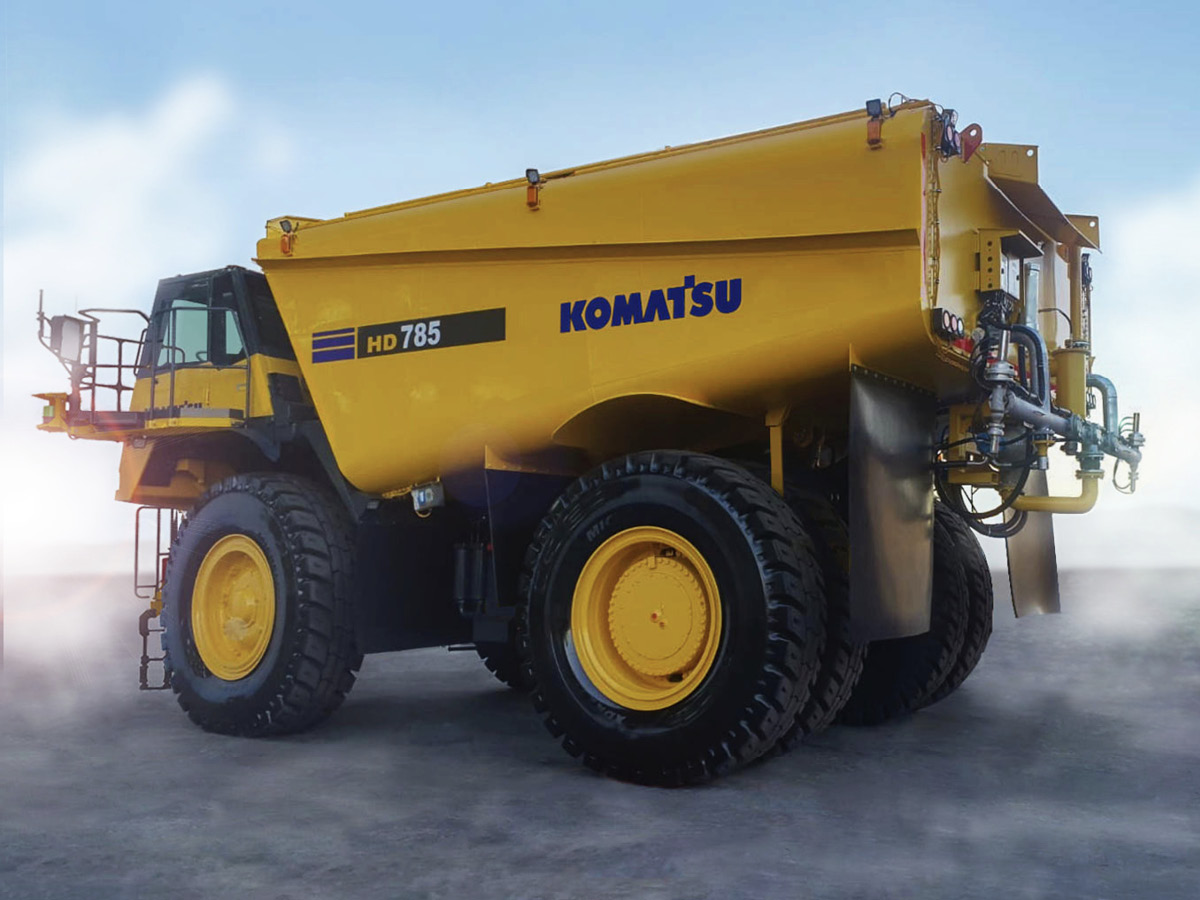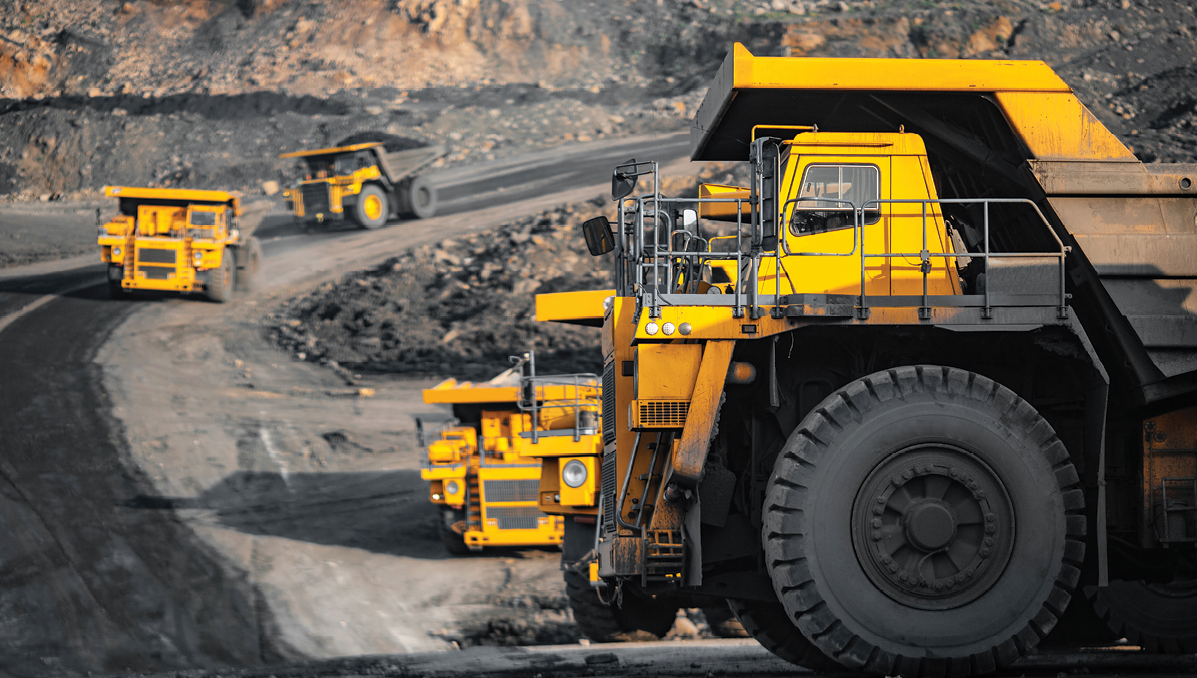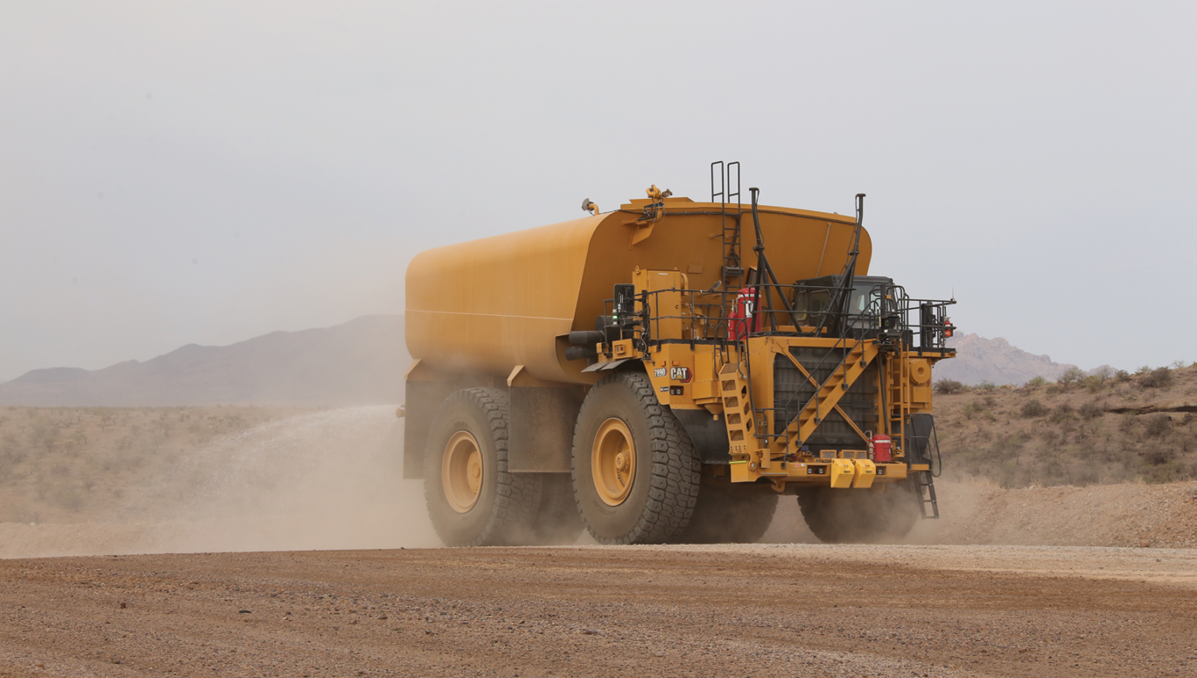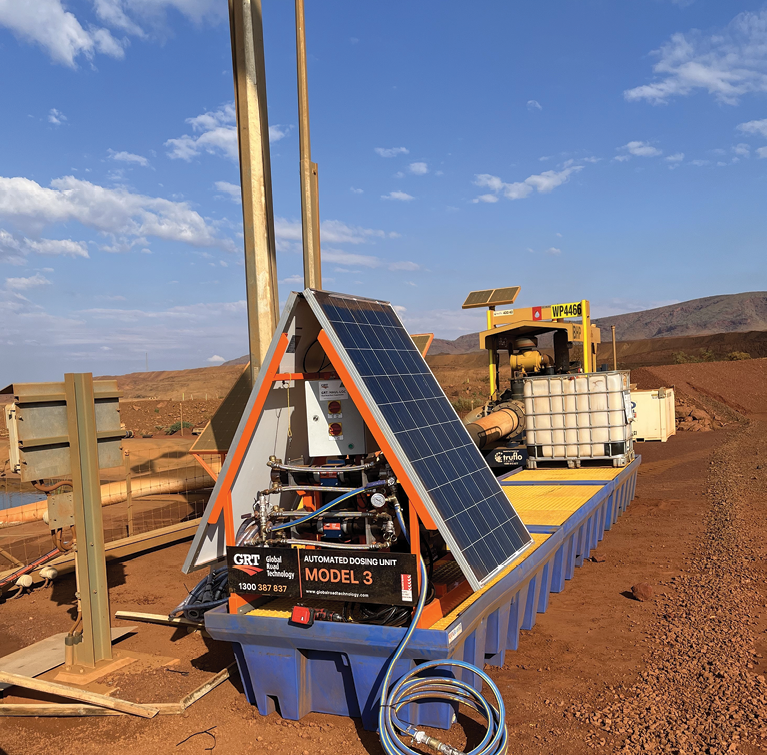Haul roads might not sound like the most exciting of topics. But scratch the road surface, and you’ll find a highly complex microcosm of the mining industry lies beneath.
By Jonathan Rowland

Why are good haul roads necessary?
Much about the mining process is complex – from exploration through initial pit design to drill and blast optimization, and efficient minerals processing operation. Compared to these processes, getting the ROM from bench to crusher is a relatively simple concept. But haulage is one of the biggest costs faced by mining operations, especially when the pit is large, deep – or both. Optimizing haulage, therefore, offers significant opportunities to reduce production costs per ton.
When considering haulage, there is a tendency to focus on the trucks. These impressive machines, generally painted in eye-catching yellow, orange or white, always capture attention at industry shows (at least those large enough to accommodate them). By contrast, haul roads can seem a rather dry (and dusty) topic. But a well-designed, built and maintained haul road is an asset worth having, and a crucial enabling factor in the safe and efficient operation of those ostentatious wheeled workhorses of the mine.
According to Roger Thompson – who literally wrote the book on haul roads – the benefits of good haul roads are manifold and include:
- Safer driving conditions;
- Lower truck operating costs (e.g., through improved fuel consumption);
- Faster cycle times (higher productivity and thus lower costs per ton);
- Reduced road maintenance (less spillage, reduced dustiness, longer service life);
- Reduced stress on truck components, such as the drivetrain, frame and suspension; and
- Improved tire and rim life.
This article will provide an overview of some of the considerations in haul road design, construction, operation and maintenance, with a focus on improving the efficiency and sustainability of mining operations.
Rolling resistance
Rolling resistance is the “measure of extra resistance to motion that a haul truck experiences, and is influenced by tire flexing, internal friction and, most importantly, wheel load and road conditions,” explained Steve Evans, a senior principal civil engineer at Stantec with extensive experience in the design and review of civil facilities in the mining industry, including haul roads.
The basic idea is that poor quality roads offer greater resistance to a haul truck’s forward momentum, and therefore increase fuel consumption and vehicle wear. It is, thus, not simply that good haul roads improve performance; bad haul roads are an active drain on a mine’s efficiency and environmental performance.
Thompson offers this perspective: “How rolling resistance impacts your haul fleet productivity depends on various factors, including grade of haul, truck type and model (electric or mechanical drive, type of engine), and load carried. A good rule of thumb for an ultra-class truck (with approx. 4.2kW/t of GVM) is that a 1% increase in rolling resistance equates to a 10% decrease in speed on ramp, or a 26% decrease in speed on the flat.”
Reducing rolling resistance is therefore a key focus in the design, construction and maintenance of haul roads.
Temporary constructions
A second conceptual challenge comes from the fact that haul roads are, by nature, temporary constructions; they also need to adapt to changes to mining operations. Spending significantly to create a highway-spec performance road is thus a not feasible approach. On the other hand, haul roads are exposed to extreme operating conditions: the daily back-and-forth of 400-ton haul trucks would be a challenge for even the most robust of roads. Haul road design needs to balance these two factors to offer cost-effective yet robust construction.
According to Evans, “the balancing of capital and operating costs is often driven by the mining company’s appetite to invest in core infrastructure to reduce long-term capital costs, de-risk operations, and guarantee business continuity. With the luxury of large balance sheets, larger mining companies can reduce their operating costs through up-front investment and planned maintenance regimes that protect their assets. In this long run, this allows operating costs to be lower and annual costs more predictable.”
On the flip side, “because they have more constraints on their finances and ability to raise funding, the junior end of the market generally favours lower capital investment – if it can be done safely – while driving value-improvement initiatives,” Evans continued. This often manifests in:
- Reduced earthworks and more aggressive road alignments. This may also require additional safety controls (e.g., radio communication when traversing blind spots).
- Reduced bridges and culvert drainage infrastructure at creek and river crossings, accompanied by an acceptance
that reinstatement may be needed after significant weather events, and accommodation for disruption to business operations in the mining, hauling and stockpiling operation.
“Under these design conditions, there is a compromise in terms of haulage speeds, cycle times, fuel use, haul truck selection and road maintenance costs, which may drive higher cost and lower efficiency,” added Evans.

Getting it right from the start
According to Thompson, it costs up to five times the original construction cost to repair or rebuild a poorly designed haul road. Getting the design right is therefore the best foundation for cost-effectiveness. A good haul road design process should consider a range of factors:
- The type of haul truck used at the mine, since different truck designs will require different road specifications.
- Road geometry: layout and alignment, both horizontal (width, curve radii, etc.) and horizontal (gradients, cross-fall/ camber, etc.), as well as sight lines and stopping distances.
- Road structure: how and with what will the road be constructed, to withstand the daily operational stresses that it will be exposed to.
- Materials and construction methods: e.g., the choice of sheeting or surfacing materials to minimize degradation of the road surface.
- Maintenance management: how often will routine maintenance (e.g., grading) be needed on each stretch of road to maintain optimal performance and minimize costs.
Note: This is necessarily a very brief dive into the world of haul road design. For those interested in the detailed view, Roger Thompson’s Mining Roads: Mine Haul Road Design, Construction & Maintenance Management (from which the above quote and points are taken) is a good place to start.
Operations and maintenance
Just as no battle plan survives contact with the enemy, so the best-designed haul road will only perform as such, until the tires of the first truck roll over it. When it comes to haul road operation, it is a daily fight against degradation. And while the design can (and should – as noted above) take degradation and maintenance into account, the operation and maintenance of a haul road is an evolving and dynamic process that responds to real-world conditions.
Haul roads are also not immune to the wider changes taking place in the mining industry. The accelerating trend to automate haul fleets poses new challenges for the operation and maintenance of haul roads. Meanwhile, environmental pressures are highlighting the benefits that high-performance haul roads offer – most obviously in terms of fuel efficiency and thus lower emissions – while also asking questions of traditional practices, notably the use of water for dust suppression.
Although commonly used at mine sites, water is “not necessarily the most cost-effective method of dust suppression,” said Stantec’s Evans. “This is especially true when water is scarce and/or evaporation rates are high.” Alternative dust suppression methods to consider include:
- Using road pavement materials in construction of the haul road that are less prone to generate dust;
- The application of dust suppression products to the surface of the haul road;
- Mixing dust suppression products with the haul road construction materials;
- Reducing vehicle volumes and speeds on the haul roads (if possible); and
- Avoiding sharp curves in the haul road.
Thinking water: dust control and surface stabilization
The question of water is “a very important aspect in the dust suppression industry, especially when it comes to making water work,” agreed Keith Nare, technical head of Communications at Australia-based Global Road Technology (GRT). “How can you best change the chemistry of water to use less of it, prolong dust suppression and contribute to the productivity of the mine?”
Nare continued: “Our GRT Haul-Loc liquid polymer, for example, when added to watering trucks, effectively reduces the water required for continuous dust suppression by at least 65% and extends the dust-suppression effects by four to five times that of water.”
GRT is also exploring the synergy between dust suppression and surface stabilization: the two are, after all, inextricably linked. The rolling effect of the tyre on the road surface dislodges fine particles from the wearing course. This both creates dust and destabilizes the road surface.
There are a range of options available to improve road surface integrity – from mechanical methods, such as geogrids, to chemical treatments, such as fly ash, lime, and cement. As Troy Adams, managing director of GRT, noted in a blog entitled “Multi-Purpose Dust Suppressants in Mining Haul Road Stabilisation,” there is also a growing range of non-traditional chemical stabilization products. These offer good dust control and environmental friendliness, alongside improving soil properties and strengthening the structural performance and durability of unsealed mine haul roads.
Products on the market are a diverse mix, including acids, enzymes, lignosulfonates, liquid polymers, resins, silicates, salts, synthetic fluids and ions. There is, however, a “preference for liquid polymers, synthetic fluids and resin stabilizers […] owing to their better performance in preventing dust and improving structural strength,” continued Adams. Distinctive features of these products include:
- Adhesive and cohesive binding, with increases in shear strength, whilst achieving dust control and material stabilisation, is typical of synthetic fluids.
- Resins bind and agglomerate surface particles, whilst reducing moisture sensitivity.
- The polymeric component of the liquid polymers improves saturation, penetration and bonding of the surface layer, post-evaporation of water.
These products offer both sustainability and cost benefits for mining operations, explained Nare: “Products that provide improved dust suppression performance compared to water alone have been shown to reduce the frequency of watering by up to a third, and thus result in lower water consumption. The spin-off is lower fuel consumption by the water trucks, reducing greenhouse gas emissions and truck operating (or contracting) costs.”
Digitalization is also a factor here. SMART (Sustainable Mining Autonomous Reporting Technology) dosing units ensure optimum chemical dosing rates at the standpipe or hydrant fill points. These units can also act as a hub for the collection of critical performance data, including water consumption, standpipe utilization, water truck efficiency, product levels, and dosing rates, as well as operational data and notifications on the product, pumps and power units.

Photo: Caterpillar
Autonomous haul roads
Autonomous haulage is also changing the way mining companies think about haul roads. According to Stantec’s Evans, the removal of the human factor raises several additional considerations and challenges to haul road design and operation, including:
- Less widening of haul roads on curves with radii less than 100 meters and at intersections;
- A small increase in the separation distance between intersections to allow the automated instruments in the trucks to clearly detect the intersection; and
- Slip lane intersection angles less than 70°, subject to the relevant approvals. Note: for non-autonomous vehicles
the minimum intersection angle is 70° for sight visibility (distance) reasons.
Autonomous trucks will also “drive along the same path every time,” continued Evans. “This results in haul road deterioration that is not uniform across the entire haul road width, as would be typical for non-autonomous vehicles. A unique situation for haul road maintenance is thus created, as a portion of the road width requires more maintenance than others.”
The presence of graders and water trucks on the haul road, even for routine maintenance, also complicates autonomous truck operations. Ultimately, this might rebalance the haul road design equation in favor of designs and construction that minimize the need for maintenance vehicle access. In the meantime, there is a move among equipment suppliers to incorporate these vehicles, notably waters trucks, into the autonomous universe.
“Studies have shown that some of the most frequent vehicle-to-vehicle incidents occur between haul trucks and watering trucks,” said Martin Cavassa, manager, Automated Haulage System (AHS) Business Development at Komatsu. “The nature of these incidents is such that most of them can be avoided through automation.”
The first deployment of a fully-autonomous water truck was announced last year by Rio Tinto at its Gudai-Darri iron ore mine in Western Australia’s Pilbara iron-ore mining region. Developed in collaboration with Caterpillar, three autonomous water trucks will join the mine’s existing fleet of autonomous haul trucks and production drills. They feature systems to detect when water application is required to maintain road conditions, as well as automated refilling.
Komatsu launched an autonomous version of its HD785 water truck at last year’s MINExpo in Las Vegas, with first commercial deployment expected later this year, Cavassa confirmed to North American Mining. Utilizing the company’s AHS technology, the truck can “travel autonomously on a pre-defined haul road, and work co-operatively with other autonomous trucks and staffed equipment,” the company said in September 2021.
Both Komatsu and Caterpillar solutions include systems to control the amount of water disbursed, according to vehicle speed, haul road inclination and watering history. “Excessively wet road conditions are a major factor in uncontrolled movement on haul roads,” explained Cavassa. “Precise and planned watering can minimize this condition, resulting in improved haul road drivability and thus higher productivity.”

Conclusion
If anything has become clear through this article, it’s that haul roads are a complicated business. They intersect not only with the day-to-day of mining operations, but also with the major megatrends facing the mining industry – from automation to emissions reduction, water management and the ongoing struggle for efficiency in a world of depleting ore grades.
Haul roads also provide a microcosm of that age-old balancing act between capital expenditure and ongoing operating costs. What should be clear, however, is that proper consideration of all the various factors involved, from the beginning of the planning process, offers the most effective pathway to a haul road that works best for the mining operation it will serve.
